Li S.Z., Jain A.K. (eds.) Encyclopedia of Biometrics
Подождите немного. Документ загружается.

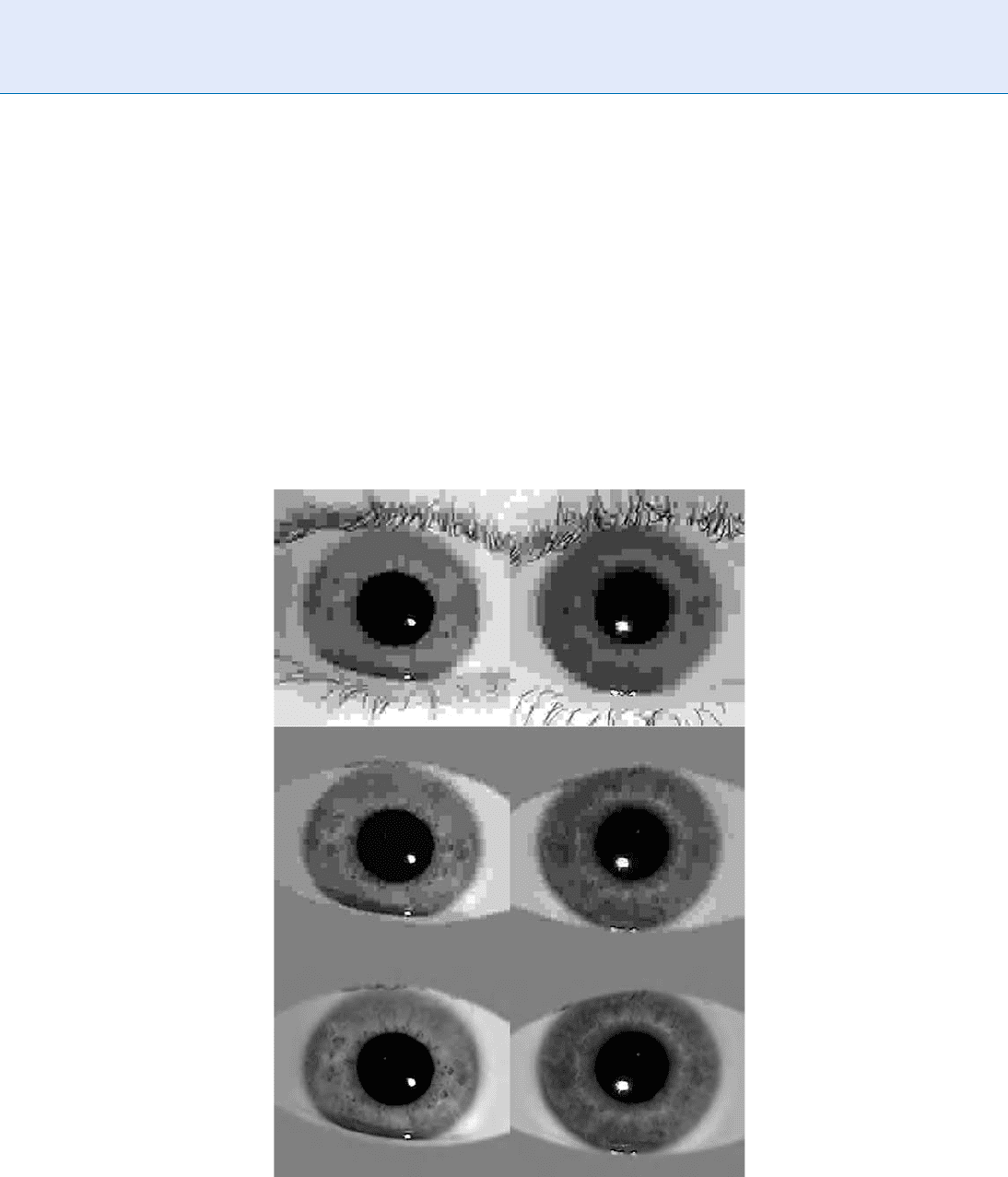
and DWT coefficient scaling. In the work presented
here those explicit control mechanisms such a s the
MAXSHIFT tool were not used, but rather the same
pixel substitution method as described earlier for ROI
was used, for comparison purposes. Three JPEG2000
compression factors (CF) of 20, 50, and 60 were cho-
sen, which yielded file sizes of 5,100, 2,000, and 1,700
bytes, respectively. The three images in the second
column of Fig.1 were created with a JPEG2000 CF of
50 and thus have a file size of only about 2,000 bytes.
Whereas JPEG generates widely varying file sizes to
deliver any given QF, JPEG2000 creates file sizes that
are closely predictable from the specifie d CF. In the
authors’ experience of compressing several thousand
iris images with JPEG2000, the standard deviation of
the distribution of resulting file sizes was usual ly only
about 1.6% of the mean [2], for any given CF. Predict-
able file size is an important benefit for fixed payload
applications [19].
Finally, it is interesting to compare visually some
examples of the iris images after compression to a
constant data size of 2,000 bytes using each of the
three different scheme s for image compression that
have been discussed here. In Fig.2, each column is
from the same NIST iris image; the rows represent
the different schemes. The top row is a simple JPEG
compression of a cropped (320 320) image but
without ROI isolation. Most of the 2,000 byte budget
Iris Recognition Performance Under Extreme Image Compression. Figure 2 Visual comparison of three schemes
for iris image compression, for images all severely compressed to the same data size of 2,000 bytes. First column uses NIST
image 239230; second column uses NIST image 239343. Top row: simple JPEG compression of the cropped (320 320)
images. Middle row: JPEG compression of the cropped images after ROI isolation. Bottom row: JPEG2000 compression
of the cropped and ROI-isolated images. At severe compression levels, JPEG2000 is vastly superior to JPEG.
830
I
Iris Recognition Performance Under Extreme Image Compression
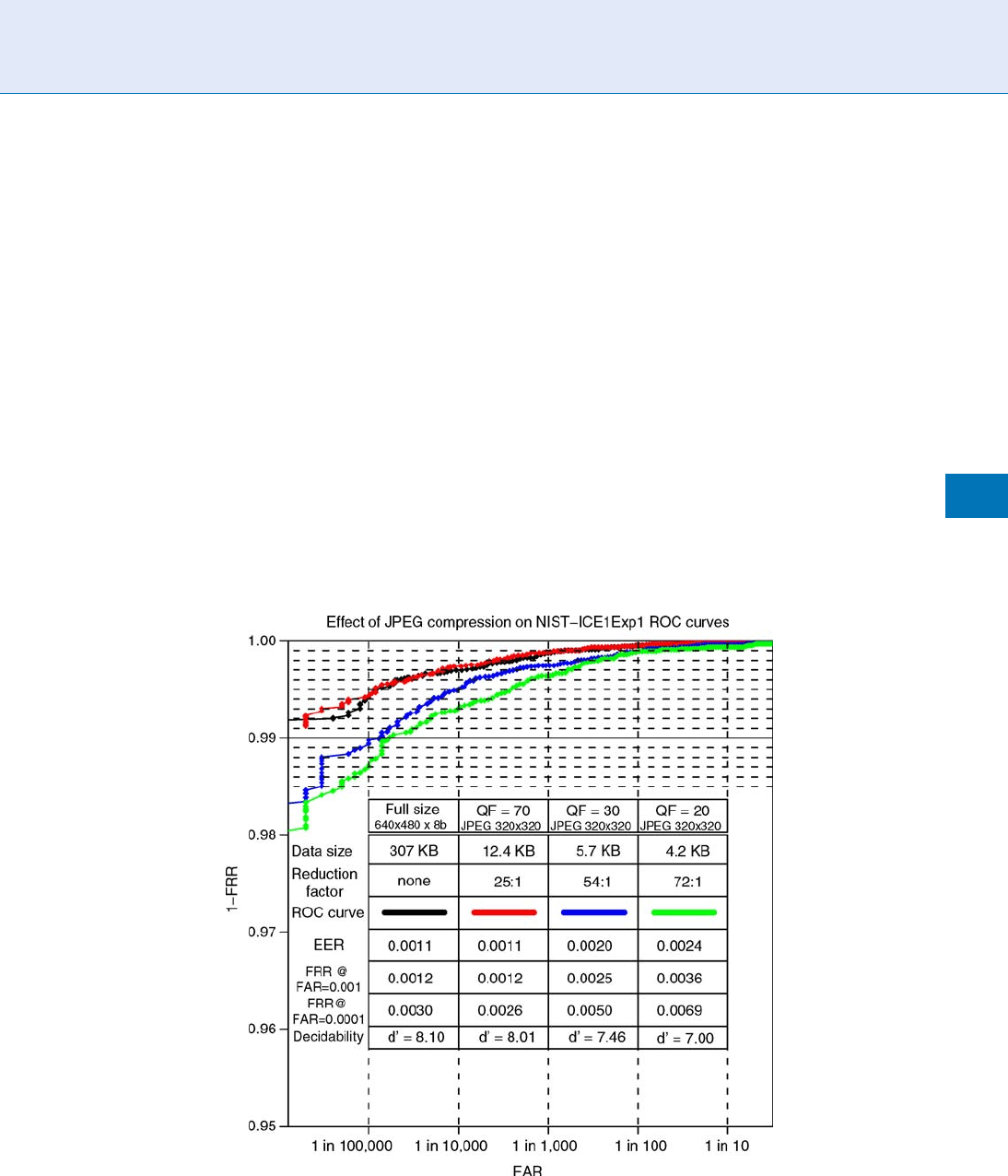
is wasted trying to encode eyelashes, and the cost on
iris texture is horrendous. The middle row shows im-
provement after ROI isolation, so most of the JPEG
budget is allocated to the iris, but the result is still very
poor. The bottom row shows the result of combining
the cropping, ROI isolation, and JPEG2000 compres-
sion for the same iris images. The improvement is
visually remarkable, and it is confirmed by very good
iris recognition performance as summarized by the
purple ROC curve (CF = 50) in Fig.5 in the next
section.
Tools for Evaluating the Effects of Iris
Image Compression
Biometric recognition performance is usually measu-
red by generating Receiver Operating Characteristic
(ROC) curves, which plot the trade-off between two
error rates (False Accept and False Reject Rates, FAR
and FRR) as the decision threshold fo r similarity
scores is varied from conservative to liberal. It is com-
mon to tabulate specific points on such trade-off
curves, such as the FRR when the decision threshold
causes an FAR of 1 in 1,000 or of 1 in 10,000, and the
point at which the two error rates are equal, FRR =
FAR = EER, the Equal Error Rate. Such ROC curves
and tabulations are presented in Fig.3 for the NIST
[12] ICE-1 gallery, both for baseline performance (un-
compressed and uncropped: black curve), and for the
three QF quality factors (coloured curves) used with
the simplest JPEG compression approach described
earlier. The coordinates of the ROC curves are semi-
logarithmic: the ordinate plots 1-FRR linearly, over
just the upper 5% of its possible range, while the
abscissa logarithmically spans many factors of 10 in
FAR, to nearly as low as 1 in a million. The number of
images and the mix of Subjects in this NIST iris
Iris Recognition Performance Under Extreme Image Compression. Figure 3 ROC curves in semi-logarithmic
coordinates for the NIST [12] ICE1Exp1 iris database, showing the impact of simple data reduction methods on
performance. Black curve shows baseline performance on the original database of full-size images. Red curve shows the
effect of simple cropping to 320 320 pixels after automatically locating and centering each iris, followed by JPEG
compression at QF¼70. Blue and green curves show the effects of more severe JPEG compression at QF¼30 and QF¼20.
Iris Recognition Performance Under Extreme Image Compression
I
831
I
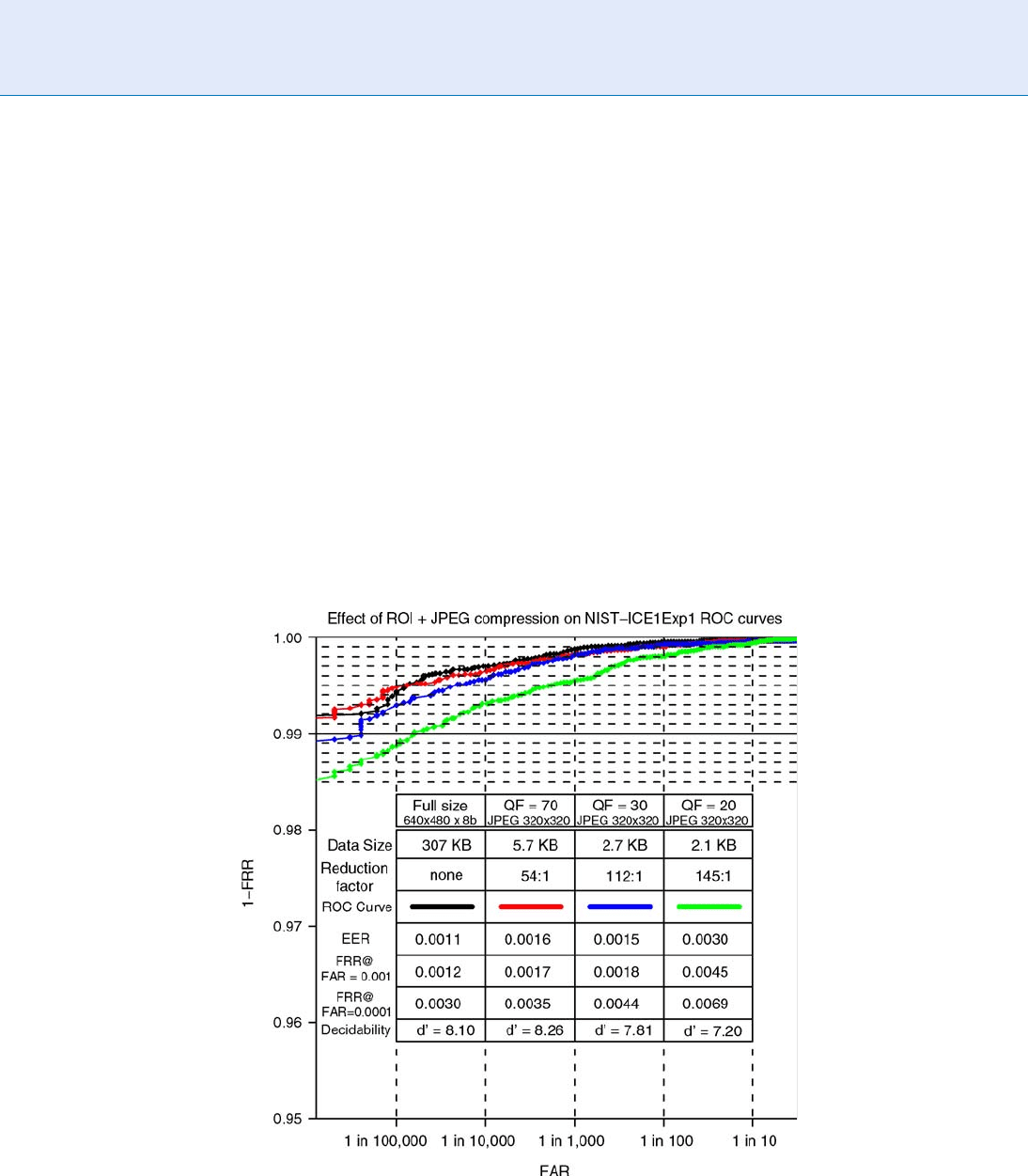
database allows 12,214 same eye matches to be tested,
and it allows 1,002,386 different eye comparisons to be
done, which means that one cannot measure a False
Match Rate (or FAR) between 0 and 1 in a million; this
determines the limit of the ROC curves on the left
extreme of these graphs.
The red ROC curve in Fig.3 shows that at a JPEG
quality factor of 70 and an overall data reduction factor
of 25:1, no performance loss relative to the baseline
(black) ROC curve is detectable. (Indeed there is even
some suggestion of a small benefit from compression,
possibly due to de-noising.) The blue and green ROC
curves show that for this scheme based only on imag e
cropping and JPEG compression, using a QF in the
range of 20–30 produces image file sizes in the range of
5,000 bytes but at the cost of roughly doubling the
FRRs and EER compared to the error rates for uncom-
pressed images.
The additional impact of the ROI isolation (JPEG +
ROI) on iris recognition performance is gauged by the
ROC curves in Fig.4. These show that for each QF
studied, iris recognition performance remained about
the same as before the ROI isolation (Fig.3), but with
the achievement of a further twofold reduction in
image data size, even dow n to the range of just
2,000–3,000 bytes per image.
Figure 5 presents the ROC curves generated by the
JPEG2000 + ROI compression scheme, together for
comparison with the black ROC curve for the baseline
gallery (uncropped, uncompressed, not ROI-isolated).
It is clear that compression as severe as 0.156 bpp
(CF = 50, file size 2.0 KB, purple curve) still allows
remarkably good iris recognition performance. For
example, the FRR remains below 1% at an FAR of 1
in 100,000. It seems extrao rdinary that image arrays
recovered from as little as 2,000 bytes of data are still so
Iris Recognition Performance Under Extreme Image Compression. Figure 4 ROC curves and data size statistics
showing the consequences of ROI isolation prior to JPEG image compression, so that the available information budget
is allocated almost entirely to the iris texture itself. The same quality factors were specified as in the corresponding
curves of Fig.3, and the recognition performance is generally comparable, but now the data reduction factors achieved
in each case are twice as great.
832
I
Iris Recognition Performance Under Extreme Image Compression

serviceable for iris recognition. It is possible that part
of the explanation lies in the similarity between the
Daubechies wavelets used for the DWT in JPEG2000
coding, and the Gabor wavelets used in the creation
[10] of the IrisCode itself, so that informati on lost in
such severe compression is not used in the IrisCode
anyway. However, a watershed seems to exist at 2,000
bytes, since a pronounced degradation becomes evi-
dent when images are further compressed to 1,700
bytes (CF = 60, blue-green ROC curve in Fig.5).
As with all biometrics, ROC curves as plotted in
Figs.3–5 reflect the overlapping tails of the two distri-
butions of similarity scores computed for images from
same or different eyes. For the present work, the simi-
larity score is a normalized Hamming Distance (HD),
which is the fraction of bits disagreeing between two
IrisCodes among the bits compared [10]. It is also
informative to see the full distributions of HD scores,
which are presented in Fig.6 for two of the compres-
sion schemes. In each panel, two different ordinate axis
scales are used to facilitate visualiz ation since there
are 1,002,386 counts in the ‘‘all against all other’’ dis-
tribution (magenta) created by comparing different
eyes, but only 12,214 counts in the distribution
(olive) made by all same eye comparisons across the
database. The upper panel shows the distributions
obtained with ROI+JPEG compression at QF¼70,
which created an average file size of 5,700 bytes. The
recognition performance obtained with that compres-
sion sch eme was almost indistinguishable from the
baseline performance (black ROC curve: no compres-
sion, ROI, or cropping). The lower panel shows the
distributions obtained with ROI+JPEG2000 compres-
sion at CF = 60, which created an average file size of
just 1,700 bytes and generated the blue–green ROC
curve in Fig.5. It is remarkable that such extremes
of compression do not have catastrophic effects on
the separability of the pair of distributions. Instead,
as seen in Fig.6, the distribution obtained from differ-
ent eyes (mag enta) is v irtually unchanged, whereas the
Iris Recognition Performance Under Extreme Image Compression. Figure 5 ROC curves and data size statistics
showing iris recognition performance when the cropped and ROI-isolated images are compressed using JPEG2000 at
various compression factors. Performance with file sizes of merely 2,000 bytes (CF¼50, purple curve) remains remarkably
unimpaired compared to baseline (black curve); but further compression begins to exact a high toll (blue-green curve).
Iris Recognition Performance Under Extreme Image Compression
I
833
I
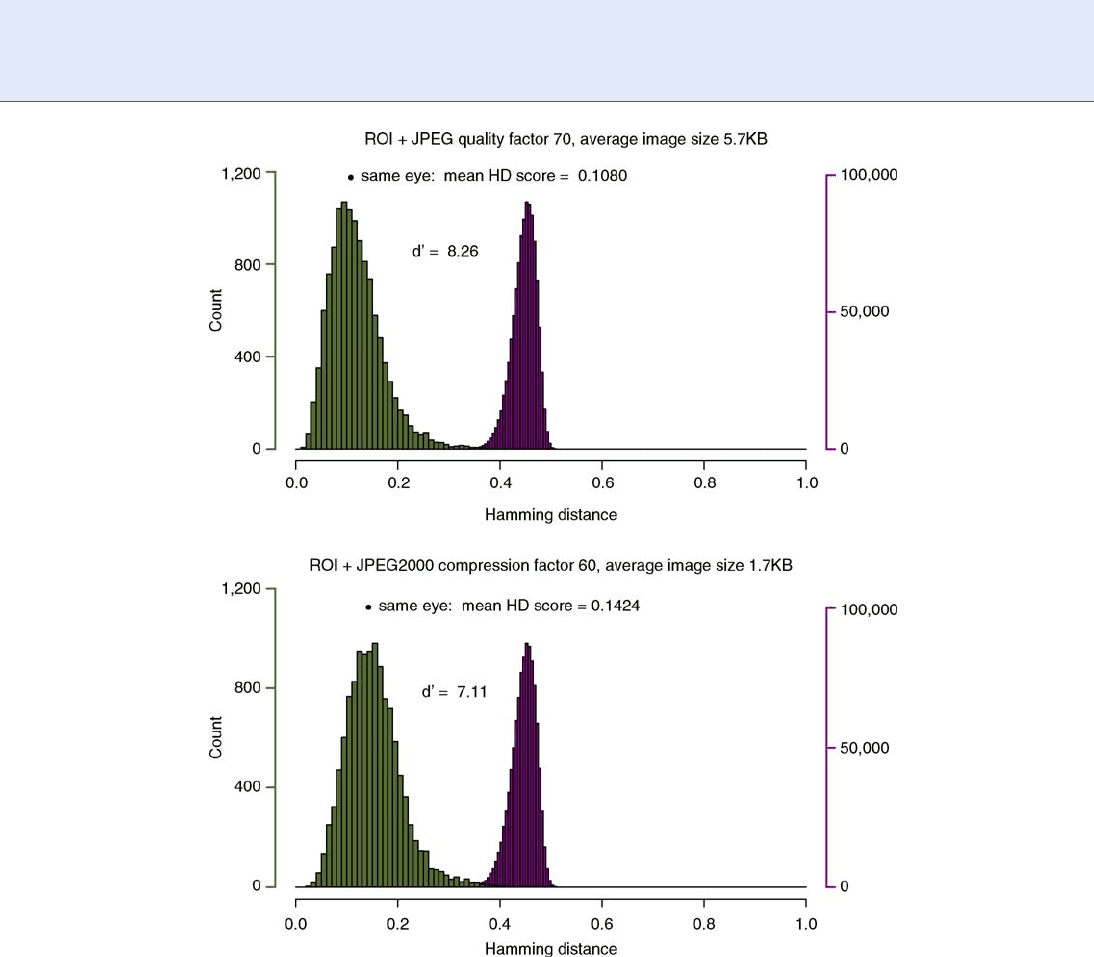
distribution obtained from same eye images (olive) is
shifted to the right by a small amount, corresponding
to an increase in the mean HD score from 0.1080 to
0.1424 as indi cated by the two dots and a projected
vertical line for comparison.
Information theory provides certain metrics for
defining the ‘‘distance’’ between two random variables
in terms of their entire probability distributions. When
both random variables are distributed over the same set
of possible outcomes, such as the HD scores that were
tallied in the histogram s for same and for different eyes
in Fig.6, then the relative entropy or Kullback–Leibler
distance is a natural way to measure the overall dis-
tance between the two distributions. As a measure of
separation, it is also called the ‘‘information for dis-
crimination.’’ Unfortunately, this measure becomes
undefined if there are so me values that only one ran-
dom variable can have while other values are accessible
only to the other random variable. Since the distribu-
tions of HD scores obtained from comparisons
Iris Recognition Performance Under Extreme Image Compression. Figure 6 Distributions of Hamming Distance scores
comparing same and different eyes in the NIST database, for two of the image compression schemes bracketing the
range of schemes studied. Even in the most severe case (lower panel) using images compressed to only 1,700 bytes, the
dual distributions have little overlap and so decisions about identity remain robust.
834
I
Iris Recognition Performance Under Extreme Image Compression

between different eyes in Fig.6 vanish for scores smal-
ler than about 0.3, and likew ise the score distributions
for same eyes attenuate to zero over much of the other
distribution, the calculated Kullback–Leibler distance
between these distributions is infinite and meaningless,
unless based on nonvanishing theoretical models for
them or by adding arbitrary quantities that then be-
come decisive for this metric. An alternative family of
distance metrics, encompassing the Fisher ratio and
Z-scores, define distance in terms of the difference be-
tween the means of the two distributions, normalized by
some function of their standard deviations. One such is
the d
0
metric of decidability in signal detection theory,
defined as d
0
¼jm
1
m
2
j=
ffiffiffiffiffiffiffiffiffiffiffiffiffiffiffiffiffiffiffiffiffi
1
2
ðs
2
1
þ s
2
2
Þ
q
, where m
1
and
m
2
are the means and s
1
and s
2
are the standard
deviations. A limitation of this metric is that by con-
sidering only the first two moments of the distribu-
tions, it makes no explicit use of skew, kurtosis, and
higher moments that are more sensitive to mass in the
tails. Thus d
0
might be said to take a ‘‘Gaussian v iew’’
of the world, whereas the skewed distributions in Fig.6
are clearly not Gaussian. Nonetheless, the d
0
scores for
each underlying pair of distributions obtained with
each of the compression schemes studied here have
been included within the ROC graphs in Figs.3–5.
They show a small but systematic trend of deteriora-
tion with more aggressive levels of image compression.
But as is clear from the two bracketing extremes pre-
sented in Fig.6, the separability of the two underly ing
distributions remains remarkable, despite the massive
compression factor reaching 180:1 reduction from the
original images.
Another metric system often used in decision the-
ory to summarize overall performance by a single
scalar statistic is the area under the ROC curve. Clearly
a value of 1.0 represents perfection since it arises only
from the complete absence of overlap between the two
distributions. The ten different ROC curves plotted in
Figs.3–5 appear to have significant amounts of missing
area, but this is an illus ion due to the loga rithmic
abscissa and the magnified ordinate ranging just be-
tween 0.95 and 1.00. In fact the area under the baseline
black ROC curve (present in all three figures) is
0.999985, and the areas under most of the other nine
curves are reduced from this value in only the sixth
decimal place.
Summary
From studying the effects of three schemes for image
compression on iris recognition performance, one is
drawn to the surprising conclusion that even images
compressed as severely as 150:1 from their original full-
size formats, to just 2,000 bytes, remain very service-
able. It is important to use region-of-interest isolation
of the iris within the image so that the coding budget is
allocated almost entirely to the iris texture rather than
to costly irrelevant structures such as eyelashes; and it
Iris Recognition Performance Under Extreme Image Compression. Table 1. Summary of the compression schemes,
resulting file sizes, and their effects on computed IrisCodes, expressed as entropy per code bit and as the fraction (HD) of
bits that were changed from those computed for the original full-size images
Strategy
Compression
parameter
Average image
size
Entropy/code
bit
Interoperability
HD
Cropping (320320) þ JPEG
compression
QF¼70 12.4 KB 0.053 bit 0.006
QF¼30 5.7 KB 0.087 bit 0.011
QF¼20 4.2 KB 0.147 bit 0.021
Cropping + ROI + JPEG compression QF¼70 5.7 KB 0.112 bit 0.015
QF¼30 2.7 KB 0.147 bit 0.021
QF¼20 2.1 KB 0.199 bit 0.031
Cropping + ROI + JPEG2000
compression
CF = 20 5.1 KB 0.130 bit 0.018
CF = 50 2.0 KB 0.179 bit 0.027
CF = 60 1.7 KB 0.219 bit 0.035
Iris Recognition Performance Under Extreme Image Compression
I
835
I

is important to use JPEG2000 instead of JPEG as the
compression protocol. Advantages of this overall ap-
proach from the perspective of Standards bodies and
interoperability consortia are that the compact image
data (when decompressed) are a native rectilinear
arrays; no proprietary methods are required; and the
distortions that can arise from alternative coordinate
transformation methods such as polar unwrapping or
polar sampling are avoided.
As concluding measures, the IrisCodes genera-
ted under each scheme were compared with those
generated for the corresponding original uncom-
pressed images. The entropy H ¼
P
i
p
i
log
2
p
i
ðÞor
uncertainty per code bit caused by each compression
scheme is tabulated in Table 1. For reference, the en-
tropy associated with the states of bits in IrisCodes
calculated from different images of the same eye, due
merely to variation in image capture, is typically 0.506
bit; Table 1 shows that the corrupting effect of the
image compression schemes is much less than this
native uncertainty in the bits of IrisCodes for a given
eye. The final column of Table 1 tabulates, as interop-
erability scores, the average HD (fraction of disagree-
ing bits) between the IrisCodes obtained before and
after image compression for each scheme and for each
compression parameter. They indicate that only about
2–3% of the IrisCode bits change as a consequence of
image compression even as severe as to 2,000 bytes.
When considered in the context of Fig.6 showing the
HD distributions for same and different eyes, it is clear
that an increment of 0.02–0.03 in HD score is a negli-
gible impact indeed. In conclusion, it app ears that
rough convergence between data length and standard
description length for this biometric system is possible.
These observations appear to vindicate the applica-
bility to biometrics of the fundamental insig hts of
Shannon [3] and Kolmogorov [4] and the relevance
of their analyses of asymptotic compressibility.
Related Entries
▶ Iris Encoding and Recognition Using Gabor Wavelets
References
1. Bradley, J., Brislawn, C., Hopper, T.: The FBI Wavelet/Scalar
Quantization standard for grayscale fingerprint image compres-
sion. Proc. SPIE (Applications of Digital Image Processing XIX)
2847 (1996)
2. Daugman, J., Downing, C.: Effect of severe image compression
on iris recognition performance. IEEE Trans. Inform. Forensics
Secur. 3, 52–61 (2008)
3. Shannon, C.: A mathematical theory of communication. Bell
Syst. Tech. J. 27, 379–423 (1948)
4. Kolmogorov, A.: Three approaches to the quantitative definition
of information. Probl. Inform. Transm. 1, 4–7 (1965)
5. Terzopoulos, D., Waters, K.: Analysis and synthesis of
facial image sequences using physical and anatomical
models. IEEE Trans. Pattern Anal. Mach. Intell 15, 569–579
(1993)
6. Cappelli, R., Maio, D., Maltoni, D.: Synthetic fingerprint-
image generation. Proc. Int. Conf. Pattern Recognit. 15,
475–478 (2000)
7. Cui, J., Wang, Y., Huang, J., Tan, T., Sun, Z.: An iris image
synthesis method based on PCA and super-resolution. Proc.
17th Int. Conf. Pattern Recognit. 4, 471–474 (2004)
8. Zuo, J., Schmid, N., Chen, X.: On generation and analysis of
synthetic iris images. IEEE Trans. Inform. Forensics Secur. 2,
77–90 (2007)
9. Daugman, J., Downing, C.: Epigenetic randomness, complexity,
and singularity of human iris patterns. Proc. R. Soc. B Biol. Sci.
268, 1737–1740 (2001)
10. Daugman, J.: How iris recognition works. IEEE Trans. Circuits
Syst. Video Technol. 14, 21–30 (2004)
11. Rakshit, S., Monro, D.: An evaluation of image sampling and
compression for human iris recognition. IEEE Trans. Inform.
Forensics Secur. 2, 605–612 (2007)
12. National Institute of Standards and Technology. Iris challenge
evaluation. http://iris.nist.gov/ice/
13. Wallace, G.: The JPEG still picture compression standard. Com-
mun. ACM 34, 30–44 (1991)
14. International Organisation for Standards: Information technology –
Digital compression and coding of continuous-tone still images.
ISO/IEC 10918 (1994)
15. Bradley, A., Stentiford, F.: JPEG2000 and region of interest
coding. In: Digital Imaging Computing Techniques and Appli-
cations. Melbourne, Australia (2002)
16. International Organisation for Standards: Information
technology – JPEG2000 image coding system. ISO/IEC 15444-1
(2004)
17. Christopoulos, C., Skodras, A., Ebrahimi, T.: The JPEG2000 still
image coding system: an overview. IEEE Trans. Consum. Elec-
tron 46, 1103–1127 (2000)
18. Hsu, R., Griffin, P.: JPEG region of interest compression for face
recognition. IDENTIX Doc. RDNJ-04-0102 (2005)
19. Registered Traveler Interoperability Consortium (RTIC): Tech-
nical Interoperability Specification for the Registered Traveler
Program. http:///www.rtconsortium.org/
Iris Recognition Systems
▶ Iris Acquisition Device
836
I
Iris Recognition Systems
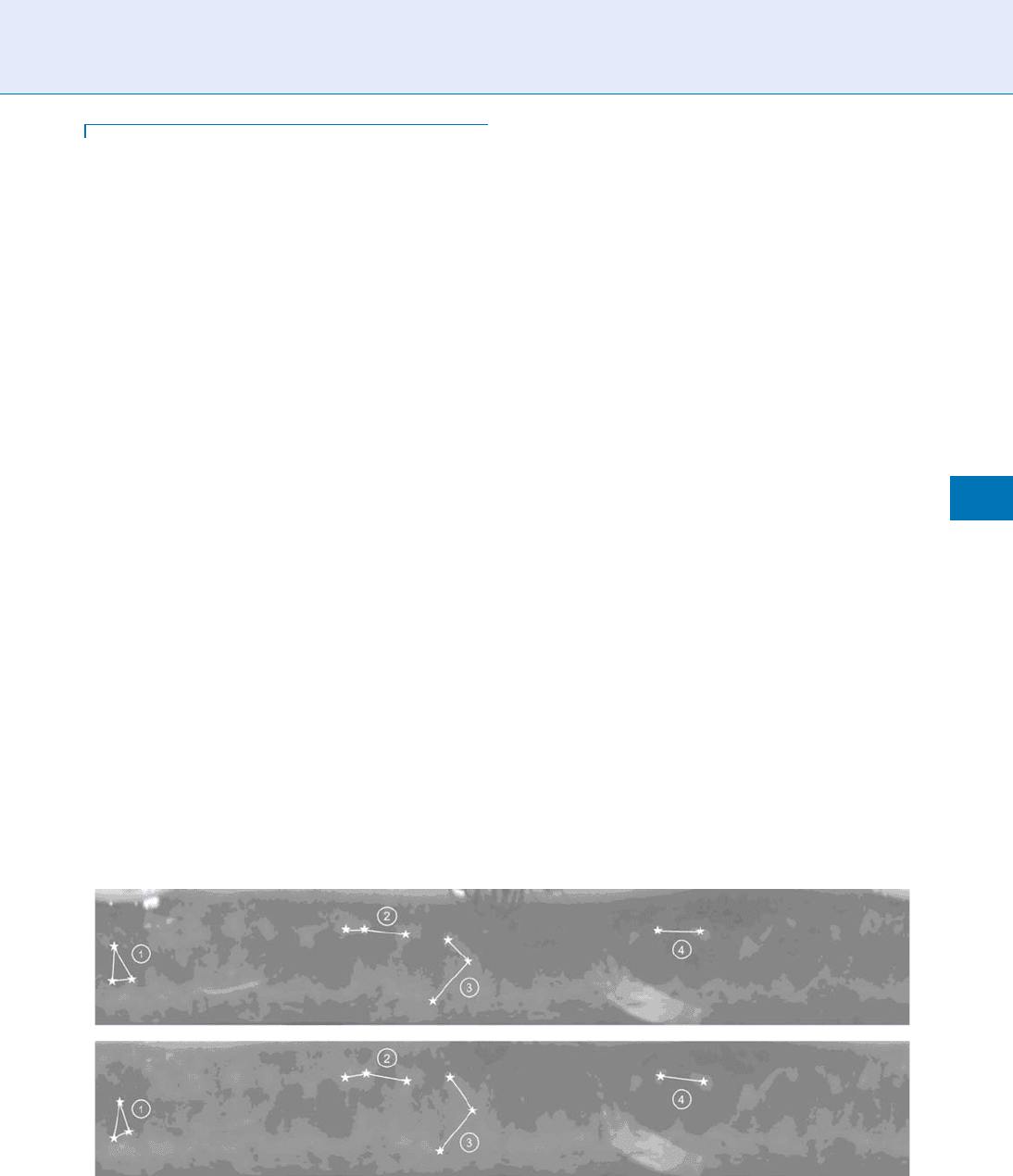
Iris Recognition Using Correlation
Filters
YUNG-HUI LI
1
,MARIOS SAVVIDES
2
,JASON THORNTON
2
,
B. V. K. V
IJAYA KUMAR
2
1
Language Technolog y Institute, Carnegie Mellon
University, Pittsbu rgh, PA, USA
2
Department of Electrical and Computer Engineering,
Carnegie Mellon University, Pittsburgh, PA, USA
Synonym
Iris Recognition with deformation and occlusion
estimation
Definition
Algorithms for iris recognition usually consist of apply-
ing feature extraction on raw iris pattern, then match-
ing against features. However, two important techniques
in machine learning and pattern recognition, namely
probabilistic graphical model, and advanced correla-
tion filters, have not been used for iris recognition. By
using probabilistic graphical models for iris texture
deformation, with the observation being the correla-
tion output derived from applying correlation filters
to local iris regions, problems of iris pattern local
deformations and occlusions can be handled and
recognition performance can be improved over that of
the conventional iris recognition algorithms.
Introduction
In the past two decades, iris recognition has emerged
as one of the most promising modalities for biometric
recognition. Many algorithms have been proposed
to improve the recognition performance of iris recog-
nition. However, there are still some obstacles which
keep us from achieving near-perfect recognition
results. Those obstacles incl ude:
1. Local deformation in iris texture: iris texture may
deform locally because of the dilation, contraction,
or motion of the pupil, as shown in Fig. 1. Note
that these deformations appe ar locally, not globally.
Therefore, a simple image global transformation
can not solve this problem. A more advanced mod-
eling technique is needed.
2. Occlusion: very often, iris texture is occluded by
many different objects, for example, eyelid, eye-
lashes, or eye glasses. Proper estimation of occluded
region is important for achieving high recognition
rate iris recognition.
The problem of deformation and occlusion estimation
is seldom addressed in iris recognition literature.
In this article, this problem is addressed by two advanced
techniques in the field of pattern recognition and
Iris Recognition Using Correlation Filters. Figure 1 Example images to show local deformation of iris texture.
(a) original iris texture (b) iris texture after local deformation. There are four regions where local deformation is observed.
Every anchor point is marked with a white star, and local anchor points are connected with white lines. Note that the
deformations are irregular with different direction in different region. Therefore, it cannot be solved by a simple image
global transformation.
Iris Recognition Using Correlation Filters
I
837
I
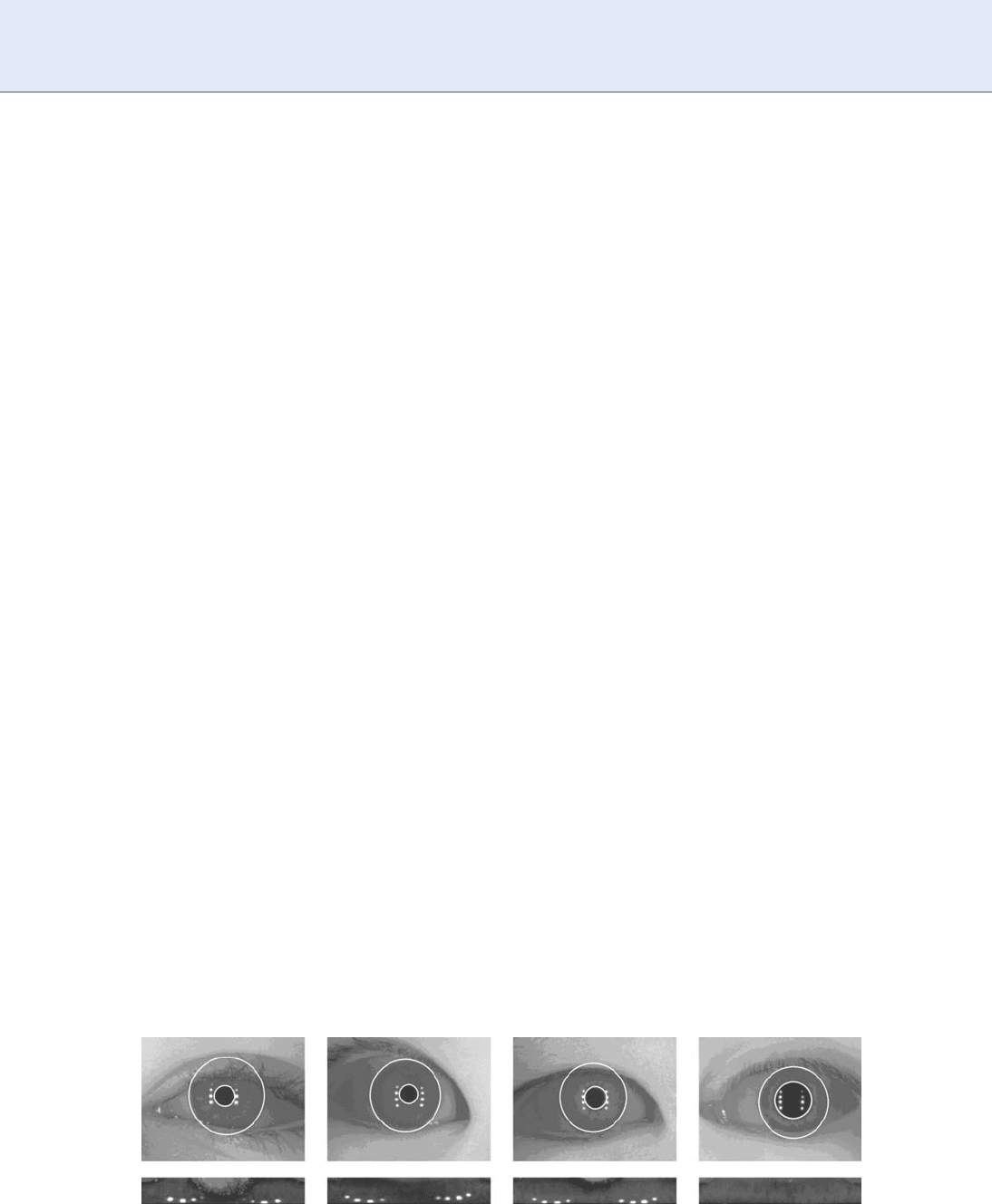
machine learning: probabilistic graphical models and
advanced correlation filters. Interested readers are re-
ferred to the original publication for more details [1–3].
Data Preprocessing
Iris images have to be preprocessed before going into
the framework of deformation and occlusion estima-
tion. The stage of data preprocessing includes iris
segmentation and coordinate transformation, as de-
scribed in the entry ‘‘Iris Overview.’’ After preproces-
sing, the iris texture map is transformed to the polar
coordinate plane, as shown in Fig. 2.
Deformation and Occlusion
Estimation
We can model the deformation and occlusion in iris
pattern with a probabilistic graphical grid, as shown in
Fig. 3. In Fig. 3a, an iris texture image is shown. The
iris texture is dissected into smaller patches in order to
observe the local deformation in more detail. In
Fig. 3b, another iris texture image from the same
class, is compared with Fig. 3a. The comparison is
done in a patch-wise fashion. Every local patch is
compared against the patch in the same location in
the other image. The vectors in the center of each
patch show how much and in what direction the
patch is deformed. In Fig. 3b, we can see that the
distance and the direction of the deformation vector
is distributed randomly, and there is no global con-
sistency among t hem.
In order to model such local deformation and
occlusion, a probabilistic graphical model, arranged
in a grid structure, is proposed, as shown in Fig. 3c.
Suppose the number of patches in an iris imag e is N
s
.
Each node d
i
in the model, i ¼ 1, ..., N
s
, represents
a 2-D discrete-valued shift vector, the true value of
which is hidden. The components of d
i
are the vertical
and horizontal shifts (in pixels) of the template region
relative to the corresponding query region. The nodes
o
i
are hidden binary-valued occlusion variables, where
=0 and =1 denote that the region is occluded and
un-occluded by the eyelid, respectively. Nodes O
i
represent the observations, which include the match
score of each local patch, and the occlusion statistics p
i
.
Match Score Computed from
Correlation Filters
Computation of the match score has to be robust to
the noise. At the same time, s ince we are e stimating
local deformation (relative shift) of each patch,
it would be even better if the match score itself
incorporates the information about the relative
in-plane translation of the compared pattern.
Advanced correlation filter is one of the techniques
in pa ttern recognition fi eld that can meet such
requirement.
Theories of advanced correlation filters have been
developed in the last two decades and they have
been successfully applied in the field of biometrics
[4–6]. There are many different versions of correlation
filters and each of them is designed according to dif-
ferent criteria [7–11]. The one which is introduced
in this article is the Optimal Trade-off Synthetic
Discriminant Function (OTSDF), one of the most
robust correlation filters [12]. The process of creating
and using OTSDF is illustrated in Fig. 4. During train-
ing stage (i.e., creation of OTSDF), a few training
images are given. From those training images,
Iris Recognition Using Correlation Filters. Figure 2 The data preprocessing stage. First row: the raw eye images with iris
boundary. Second row: the iris texture map after segmentation and coordinate transformation.
838
I
Iris Recognition Using Correlation Filters
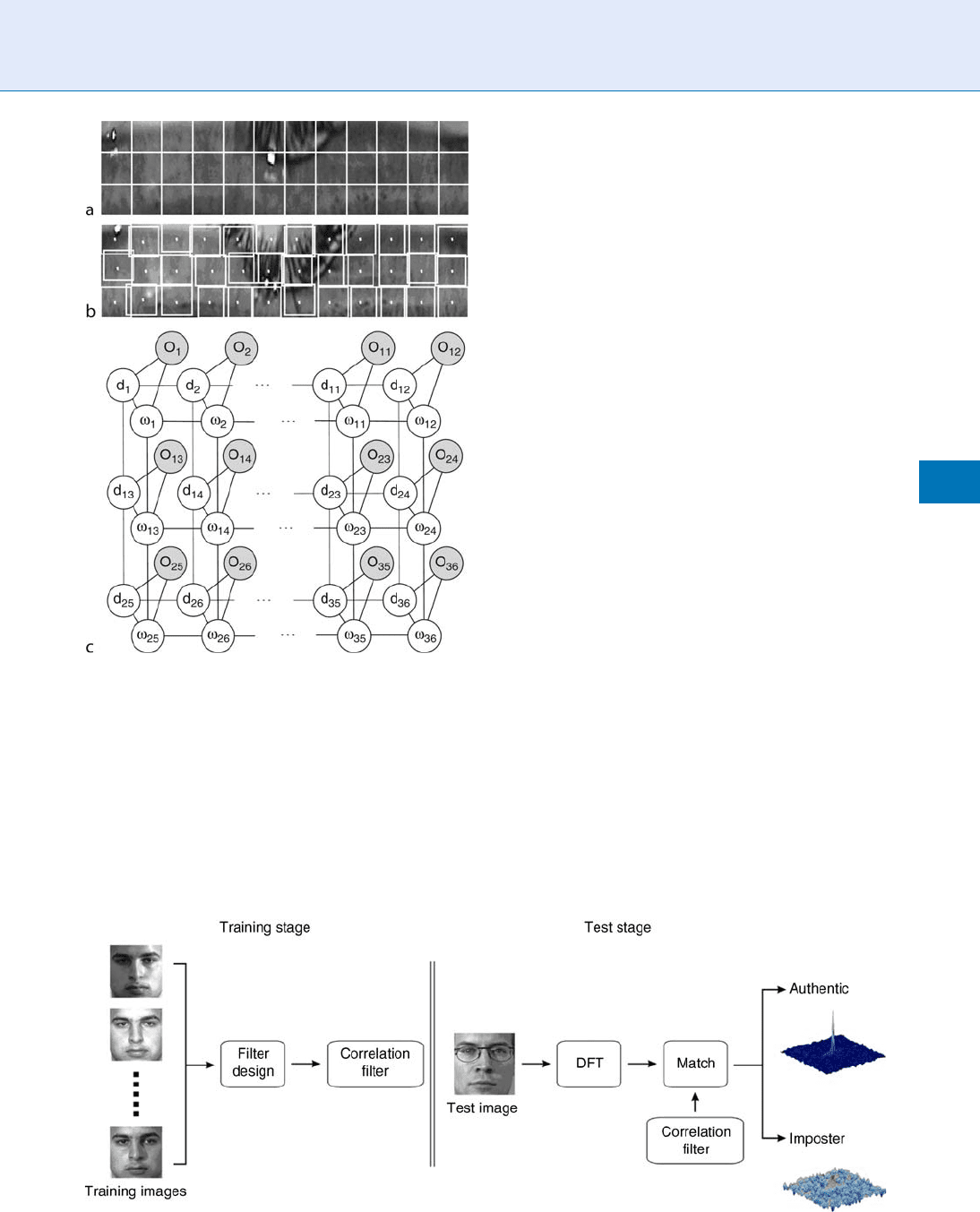
OTSDF can be computed using a closed form expres-
sion in 2D Fourier domain. The expression is designed
to minimize both the
▶ average correlation energy
(ACE) and the
▶ output noise variance (ONV), but
at the same time, make the output of the peak to be
the preset value if the test image is one of the training
images itself. Let h represent a vectorized form (e.g., by
lexicographic scanning of the array into a column
vector) of the correlation filter H(u, v), x
i
represent
the vectorized form of the
▶ Fourier transform of
training image i, D represent a diagonal matrix
with the average squared magnitude of all x
i
along its
diagonal, and N is the power spectral density of the
input noise lexicographically re-ordered along its diag-
onal. The ACE and ONV can be represented as
ACE ¼ h
þ
Dh
ONV ¼ h
þ
Nh
ð1Þ
where + denotes complex conjugate transpose.
As stated above, the criteria of the filter design is to
minimize both ACE and ONV subject to the linear
peak constraints for the input training images. This is
equivalent to minimizing a linear combination of the
two terms (determined by a parameter a), subject to
the same linear constraints. Lagrange optimization
yields a closed from solu tion
h ¼ A
1
XðX
þ
A
1
XÞ
1
u ð2Þ
where
A ¼ aN þ
ffiffiffiffiffiffiffiffiffiffiffiffiffi
1 a
2
p
D ð3Þ
Iris Recognition Using Correlation Filters. Figure 4 Left: The training stage of OTSDF; Right: the testing stage of OTSDF.
Iris Recognition Using Correlation Filters. Figure 3
Probabilistic graphical model for deformation and
occlusion estimation. (a) the iris pattern dissected into
patches (b) another iris pattern of the same class, dissected
into patches. The vectors in the centers of the patches
indicate the relative deformation of that patch. (c) the
graphical model used for deformation and occlusion
estimation.
Iris Recognition Using Correlation Filters
I
839
I
